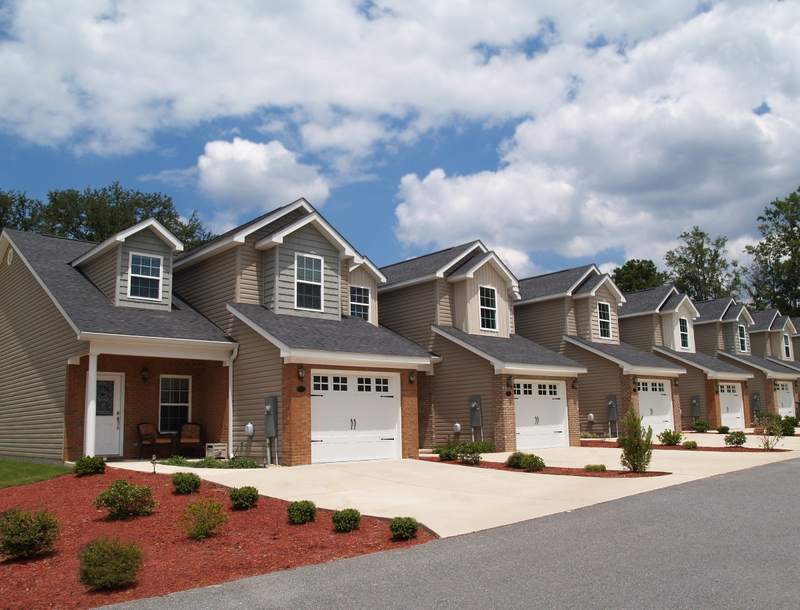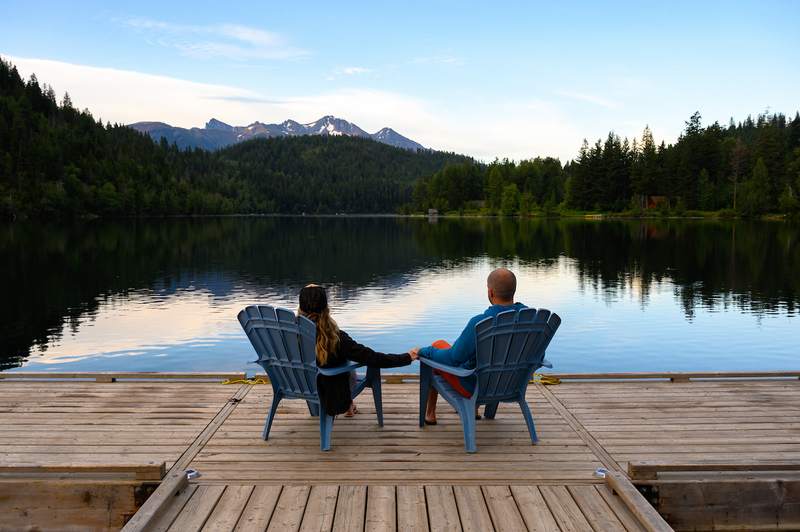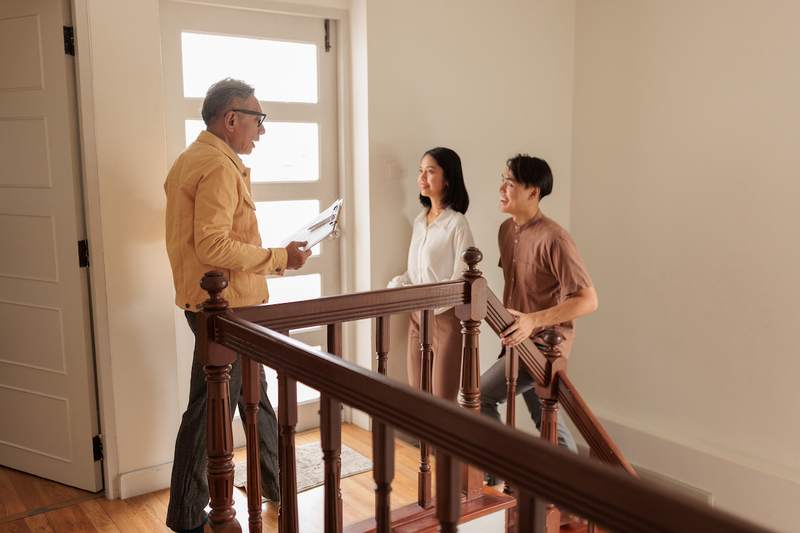When you come across the term “patio home,” your mind might envision a single-family home attached to a private recreation area for outdoor dining. While some patio homes have an actual patio, this term indicates a specific type of real estate.
Patio homes are an option for buyers who want a relatively affordable housing option, value accessibility in a home, and don’t mind potentially sharing home features with their neighbors.
Key Takeaways:
- A patio home is different from a condominium or townhouse because patio homes are never more than 1 1/2 stories tall.
- Due to their low maintenance cost and easy accessibility, patio homes may be ideal for older homebuyers.
- It’s important to know the pros and cons of buying a patio home before you purchase one.
What To Know About Patio Homes
Patio homes vary in appearance, but most are single-story buildings. Some share a wall with their neighbors, while others only share landscaping or a fence. They appeal to many first-time homebuyers due to their small footprint and limited maintenance requirements.
“A patio home is a single-level residence that is typically smaller in size and has a private outdoor space, such as a patio or courtyard,” says Doug Van Soest, co-founder of SoCal Home Buyers in Murrieta, California.
What’s the difference between a patio home, condo, and townhouse?
In contrast to a condo or townhouse, which usually have neighbors surrounding your unit, patio homes can afford a bit more privacy.
“The main difference between a patio home and a townhome is the size and layout,” says Jeff Johnson, owner of Simple Homebuyers in La Plata, Maryland. “Patio homes are typically smaller, single-story homes with outdoor living space, while townhomes are multistory attached homes that share walls with neighboring units.”
A patio home also comes with rights to the lot it sits on, while condo owners won’t find any land rights.
Here’s a breakdown of some distinguishing characteristics between different home types:
Comparing Different Types of Homes
| Home Type | Neighbors | Number of Levels | Ownership |
| Patio home | May share a wall or outdoor space with neighbors. | Usually one. | You own the building and the land. |
| Condominium | May share walls, indoor common areas, and outdoor space with neighbors. | Often located within a building with multiple levels. | You only own the space within the walls of your unit; no land rights. |
| Townhouse | Share one or more walls with neighbors. | Usually two levels. | You own your portion of the building and the land. |
| Brownstone | Defined by the type of stone used on the exterior walls. May share walls with neighbors. | Can be two or more levels. | You own your portion of the building and the land. |
| Apartment | Often share walls and common areas with neighbors. | The building often has multiple levels. | You only rent the unit. |
| Single-family home | No shared walls or outdoor space with neighbors. | Can be any number of levels, usually one to three. | You own the building and the land. |
| Multifamily home | Single building with up to four separate units. | Can be any number of levels, usually one to three. | You own the building and the land, and can rent out other units. |
| Co-op | Varies | Varies. | You own a share of the nonprofit that allows you to live in the building. |
Where are patio homes popular?
Patio homes tend to be easier to find in the Northeast. However, patio home communities are available around the country.
If you’re looking for a patio home in your area, consider reaching out to your real estate agent.
Other names for patio homes
Patio homes go by many names:
- Cluster homes.
- Garden homes.
- Garden villas.
- Courtyard homes.
- Club homes.
- Carriage homes.
While the name might change, the definition of a patio home remains the same.
Who Are Patio Homes For?
Thanks to patio homes’ minimal maintenance requirements and lack of stairs, their appeal to older homeowners is easy to see. However, patio homes can also attract younger homebuyers looking to break into the housing market at a relatively affordable price point.
“A patio home is best for individuals or couples who are looking for a low-maintenance lifestyle and prefer a single-level living space,” Soest says. “This type of housing is often popular with retirees or empty nesters who want to downsize without sacrificing privacy or outdoor living space.”
Factors To Consider When Buying a Patio Home
There are many things to consider when hunting for the right patio home. Here’s a breakdown of important factors:
- Homeowners association fees and requirements. Most patio homes belong to an HOA, which means you’ll have to pay dues and follow its rules. It’s important to look at the additional cost and make sure you’re comfortable with any restrictions imposed by the HOA.
- Amenities. A patio home may come with perks, like a community pool or tennis courts. If you have specific amenities in mind, shop around for a community that suits your needs.
- Proximity to neighbors. Some patio homes share a wall with their neighbor, but others don’t. Find a home that strikes the right balance of price and privacy for your tastes.
- Maintenance costs. A small yard might come with relatively low maintenance costs. But all homes come with some level of required maintenance that adds to the costs of buying a home.
- Upgradable. Do you have certain features that you want in your patio home? Confirm that you can make improvements that add value to your home and aren’t restricted by an HOA.
- Customizable. You might find that some developers are willing to make customizations to a new-construction home. Don’t be afraid to ask around to get what you’re looking for.
- Insurance costs. Homeowners insurance is an unavoidable expense if you’re taking out a mortgage. But even if homeowners insurance isn’t required, it’s a good idea to have coverage.
- Home price. You should make sure the patio home fits your budget. Beyond the list price, consider what closing costs you’ll need to cover. Closing costs are typically 2% to 5% of the purchase price.
Related: What Is a No-Closing-Cost Mortgage? How To Get One
Pros and Cons of Buying a Patio Home
Every real estate transaction has pros and cons. Here’s what to keep in mind about buying a patio home.
Benefits of buying a patio home
- Accessible. The single-story nature of patio homes makes them easier for many older homeowners to navigate. You won’t have to trudge upstairs to get around the house.
- Affordable. The smaller size of patio homes tends to make them more affordable than traditional single-family homes.
- Easier to maintain. Without a big yard, you’ll likely find that maintaining a patio home is easier.
- Sense of community. Some patio home communities sponsor activities, which can make it easier to meet your neighbors and make friends.
Drawbacks of buying a patio home
- Small outdoor space. While your patio home might have an outdoor space, it will likely be a relatively small area.
- Less privacy. With small lots, most patio homes come with a limited amount of privacy.
- HOA dues and restrictions. Most patio homes come with an HOA. In addition to charging a monthly or annual fee, the HOA may limit what you can do with your home.
How To Finance a Patio Home
A patio home is a major purchase, which means most people will need to turn to financing. If qualified, you can tap into a range of mortgage options to buy a patio home:
- Conventional loan. A conventional loan requires a credit score of 620 and a down payment of at least 3%. In most of the country, the loan limit is $726,200.
- Jumbo loan. If you need a bigger loan, jumbo loans are an option. The amount you can borrow boils down to your unique situation and the lender’s requirements.
- Federal Housing Administration loan. FHA loans are for people with a credit score of at least 580 who are looking to purchase a home with 3.5% down. Borrowers with a credit score of at least 500 can also pursue an FHA loan if they are willing to put down 10%.
- Veterans Affairs loan. Without set credit score and down payment requirements, VA loans are available for veterans and active-duty service members who meet specific qualifications.
Learn More: How To Save For a Down Payment on a Home
Should You Buy a Patio Home?
The decision to buy a patio home is a personal one. Take some time to consider your homeownership goals.
If you’re looking for a lower-maintenance home that is more accessible and comes at a more affordable price point, a patio home might be a good fit. However, you might not want the closer proximity to other homeowners.
If you’re on the fence, reach out to a real estate agent. By taking a tour of a patio home, you’ll have a better idea if it’s something you want to pursue.
Patio Home FAQ
Here are the answers to some frequently asked questions about patio homes.
You can find some patio homes in gated communities, but not all of them.
A patio home may or may not have a patio. The defining features of a patio home include the smaller size of the home and the closer proximity to neighbors, not the outdoor space.
The Bottom Line on Patio Homes
While a patio home might not come with the outdoor recreation area that springs to mind, these single-story homes have a lot to offer. The right buyer may prefer the manageable size and more affordable price point of a patio home. But don’t hesitate to take a tour before signing up for this style of living.






